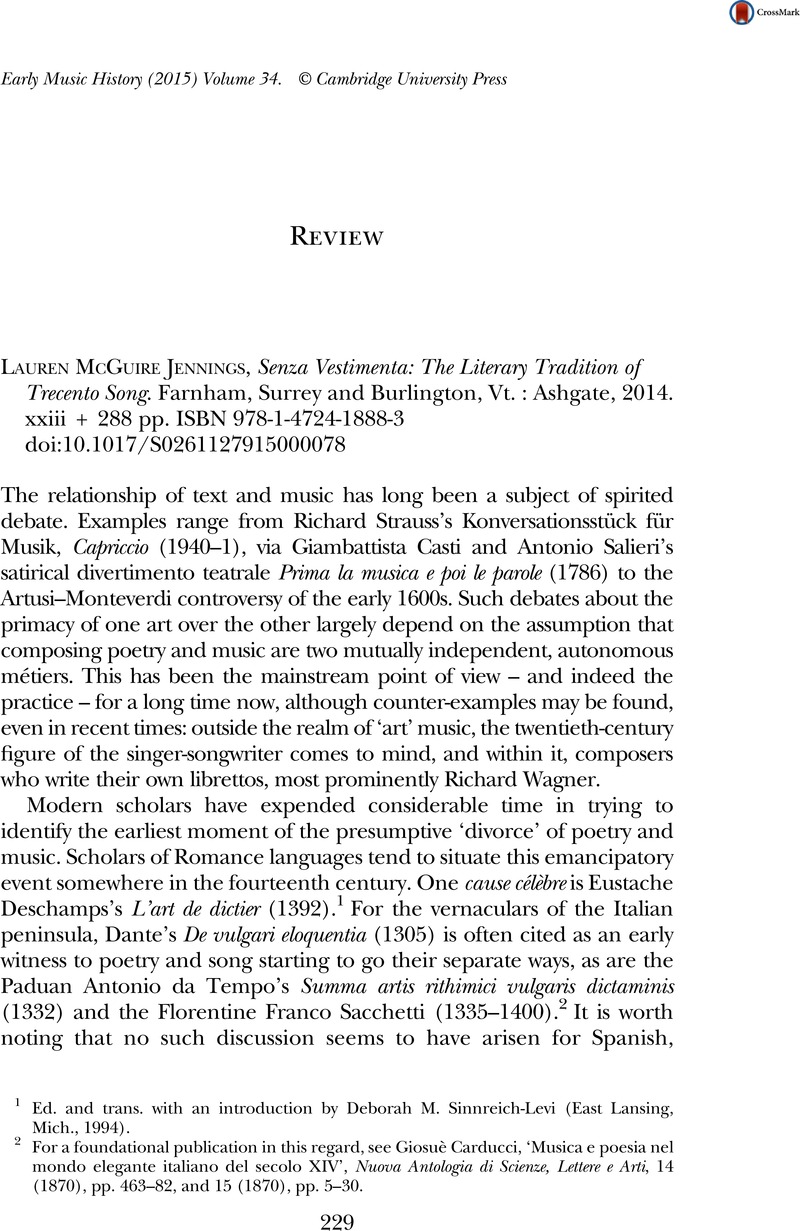No CrossRef data available.
Article contents
Lauren McGuire Jennings, Senza Vestimenta: The Literary Tradition of Trecento Song. Farnham, Surrey and Burlington, Vt.: Ashgate, 2014. xxiii + 288 pp. ISBN 978-1-4724-1888-3
Published online by Cambridge University Press: 23 September 2015
Abstract

- Type
- Review
- Information
- Copyright
- © Cambridge University Press 2015
References
1 Ed. and trans. with an introduction by Deborah M. Sinnreich-Levi (East Lansing, Mich., 1994).
2 For a foundational publication in this regard, see Carducci, Giosuè, ‘Musica e poesia nel mondo elegante italiano del secolo XIV’, Nuova Antologia di Scienze, Lettere e Arti, 14 (1870), pp. 463–482Google Scholar, and 15 (1870), pp. 5–30.
3 Seminal here, among others, are Zumthor, Paul, La Lettre et la voix: De la ‘littérature’ médiévale (Paris, 1987)Google Scholar; Huot, Sylvia, From Song to Book: The Poetics of Writing in Old French Lyric and Lyrical Narrative Poetry (Ithaca, NY, 1987)Google Scholar; Fauvel Studies: Allegory, Chronicle, Music, and Image in Paris, Bibliothèque nationale de France, MS français 146, ed. Margaret Bent and Andrew Wathey (Oxford, 1997); and, from a different angle, Carruthers, Mary, The Book of Memory: A Study of Memory in Medieval Culture (Cambridge, 1990; rev. edn. 2008)Google Scholar; and Caroline Walker Bynum’s work on medieval material culture such as her Christian Materiality: An Essay on Religion in Late Medieval Europe (New York, 2011).
4 For some recent examples, see Leach, Elizabeth Eva, Guillaume de Machaut: Secretary, Poet, Musician (Ithaca, NY, 2011)CrossRefGoogle Scholar; Dillon, Emma, The Sense of Sound: Musical Meaning in France, 1260–1330 (New York and Oxford, 2012)CrossRefGoogle Scholar; and Plumley, Yolanda, The Art of Grafted Song: Citation and Allusion in the Age of Machaut (New York and Oxford, 2013)CrossRefGoogle Scholar.
5 ‘The Motets of Philippe de Vitry and the Fourteenth-Century Renaissance’, Early Music History, 12 (1993), pp. 119–50.
6 ‘Singing Texted Songs from Untexted Songbooks: The Evidence of the Basler Liederhandschriften’, in Jean-Michel Vaccaro (ed.), Le Concert des voix et des instruments à la Renaissance (Paris, 1995), pp. 121–44.
7 At least in English. Italian scholars such as Gianluca d’Agostino have been working on these sources in recent years but did not publish their findings outside Italy, thereby restricting reception of their work. See, for example, his ‘La tradizione letteraria dei testi poetico-musicali del Trecento: Una revisione per dati e problemi. (L’area toscana.)’, in Antonio Delfino e Maria Teresa Rosa-Barezzani (eds.), Col dolce suon che da te piove: Studi su Francesco Landini e la musica del suo tempo, in memoria di Nino Pirotta (Florence, 1999), pp. 389–428.
8 For another recent contribution, see Jeserich, Philipp, Musica naturalis: Speculative Music Theory and Poetics, from Saint Augustine to the Late Middle Ages in France, trans. Michael J. Curley and Steven Rendall (Baltimore, 2013)Google Scholar. The German original appeared under the title Musica naturalis: Tradition und Kontinuität spekulativ-metaphysischer Musiktheorie in der Poetik des französischen Spätmittelalters (Stuttgart, 2008).
9 This is to be understood in addition to the cantasi come tradition for lauda singing, which is already quite well researched. See, for example, Wilson, Blake McDowell, Singing Poetry in Renaissance Florence: The Cantasi come Tradition (1375–1550) (Florence, 2009)Google Scholar.
10 Kügle, Karl, ‘De ordinatio van het “Gruuthuse”-liedboek en de Europese muziek omstreeks 1400’ [The ordinatio of the ‘Gruuthuse’ song book and European music around 1400]’, in Frank Willaert (ed.), Het Gruuthuse-handschrift in woord en klank: Nieuwe inzichten, nieuwe vragen [The Gruuthuse Manuscript, its Texts and its Music: New Insight, New Problems] (with an introduction and summaries in English) (Ghent, 2010), pp. 81–112Google Scholar at 94–5.
11 Support by the Royal Netherlands Academy of Sciences (KNAW) in the form of a senior fellowship (2014–15) at the Netherlands Institute for Advanced Study in the Humanities and Social Sciences (NIAS), Wassenaar, The Netherlands, is herewith gratefully acknowledged.




